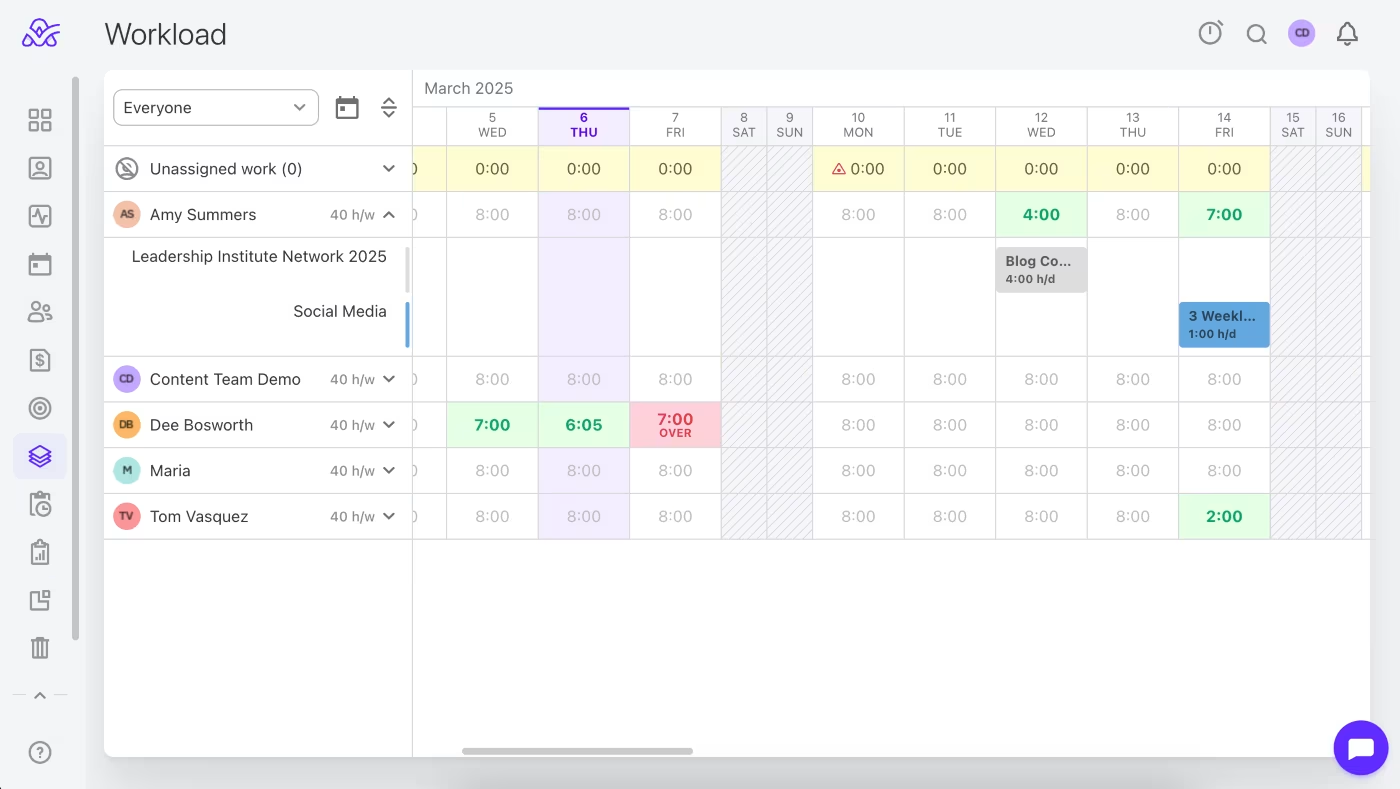When it comes to SMEs, we mostly hear success stories because, let’s face it, everybody loves a good success story. However, we don’t get to hear much about how tough and competitive it is out there, and how many SMEs actually go belly up.
According to research, only 48.9% of small businesses make it to two years. And given that there are 33.3 million businesses in the US alone, that number seems even more intimidating.
So, small businesses try and do their best to stay afloat and ahead of competitors, but then they run into a wall. According to Gallup, 76% of employees experience burnout. So how do you keep your SME alive without running your employees into the ground? Can you even have both? The answer is yes.
As for the how, we are going to look into 11 effective workload management strategies that can help your SME prevent employee burnout.
Managing an overwhelming workload is not just in your employee’s interest but in your SME’s or agency’s interest as well.
When an employee is experiencing burnout, not only are they not going to turn in their performance, but they will either become disengaged at work (look up “quiet quitting”) or actively look for another job.
According to research, 35% of workers said that unsustainable workloads caused them to leave a job without another one as backup. And it’s going to cost you a lot more to hire and onboard a new team member than to keep your existing ones functional and happy.
Without further ado…
1. Leverage Task Prioritization Frameworks
When you are running an SME or an agency, every single task matters, there is no fat to trim, we get it. But, some tasks are more equal than others.
In other words, you should be aware of which tasks have the highest impact on your business, are the most urgent, or deliver the biggest value to your organization. Not all tasks fit that description.
Once you identify your high-impact tasks, you can manage your organization’s workload more effectively by utilizing some of the following task prioritization methods:
Eat The Frog: Using this framework, your employees tackle the most challenging or impactful task first thing in the morning, which enables them to build momentum and beat procrastination.
Most Important Task (MIT) Method: This approach requires your team members to focus on completing one to three strategic tasks per day.
The Pickle Jar Theory: “Rocks” are high-value tasks and are done first, then you have your “pebbles” (moderate-value tasks), and “sand” (minor tasks, administration, busy work).
ABCDE Method: Tasks are categorized based on importance, with A tasks being the most critical, and E tasks being those which you can eliminate.
1-3-5 Rule: Workload is limited to completing one major, three important, and five minor tasks within a single day.
Pareto Principle: Also known as the 80/20 rule, this method states that 80% of results come from 20% of effort. Finding and focusing on such tasks can boost efficiency.
Eisenhower Matrix: Your employee’s tasks are divided into four quadrants using their urgency and importance as prioritization criteria.
MoSCoW Method: This method classified tasks into four categories: must-haves, should-haves, could-haves, and won’t-haves.
2. Resource-Conscious Workload Planning
SMEs and agencies have their work cut out for them because they often operate using limited resources. Sure, it would be great if you could hire more people for your team, but what happens if you can’t afford it?
This is where resource-minded workload planning comes into play to make sure that the tasks are distributed equally, with not only business demands taken into account, but your team’s true capacity as well.
Here are some of the most useful resource-conscious practices your organization can adopt:
a.) Be mindful of seasonal and cyclical fluctuations: Take seasonal workload peaks into account (for example, the holiday season in retail and eCommerce) and create your plans accordingly to not overwhelm your employees.
b.) Make workload adaptive: Be prepared to handle demand surges by hiring additional staff on a temporary basis, redistributing the workload, or providing cross-training opportunities.
c.) Review the workload on a regular basis: Your team’s capacity might change depending on a number of factors, and it’s up to you to respond to those changes and keep them productive while keeping stress and burnout at bay.
3. Use Workload Management Software
Keeping track of who does what in your SME or organization can be done in Excel sheets, but only up to a point. Once your team has to handle multiple projects or starts to grow, you will need workload management software.
How exactly does workload software help? It enables your business to track tasks more efficiently, allocate resources, and identify your priorities in real time.
You can do all of that, plus a whole lot more, with ActiveCollab, which acts as a productivity workspace that enables you to handle all aspects of your SME’s workload. Plus, it’s tailor-made for SMEs, agencies, and organizations with 15-50 employees.
Using ActiveCollab, you can:
- Distribute the workload fairly
- Keep track of tasks, deadlines, and progress of your projects
- Use time-tracking tools
- Generate detailed reports to identify weak areas
But, more importantly, ActiveCollab sports a dedicated Workload feature that enables you to:
Manage both individual and team capacity: Easily zero in on employees who are overwhelmed and balance the workload in real time.
Manage unassigned tasks: Distribute unassigned tasks across the entire SME based on team members’ availability or resources.
Visualize your team’s capacity: Workload uses Gantt-like charts to help you look at the team members' availability, as well as days when they will be off.
Scale your efforts: By identifying areas where your employees at near their full capacity, you can start to plan new hires to bolster your team’s capabilities.
Take a quick look at how Workload works:
4. Smart Delegation and Role Optimization
There is a lot more to delegation than might first meet the eye. It’s not just an act of pawning off your work onto somebody else.
It does lighten the workload, but it also empowers your employees to take ownership and grow their skills, provided that you are with them every step of the way to provide feedback.
Plus, it signals your team that you have trust in them and their abilities. However, it’s not just about delegating work to the person who is available at the time, but the one that is the right fit in terms of skills and expertise, and who can handle it in terms of their own workload.
In order for your team members to take ownership, they need to be aware of their roles and responsibilities first.
When you provide a clear definition of those right off the bat, you not only reduce the chance of confusion but also set the stage for innovation, as your employees will feel confident to innovate and create solutions that are in line with what they do best.
5. Set Boundaries
It’s a well-known fact that having a healthy work-life balance is beneficial not only for the individual but for the entire organization.
However, because SMEs and agencies usually feature small teams, work has a tendency to spill over into your employee’s personal time.
Why should you avoid this? Well, apart from treating your employees as human beings, you give up the short-term wins for sustainable productivity and people who are engaged and satisfied with their job.
Here are some of the most effective ways of setting boundaries for your SME team:
- Define specific work hours
- Limit unnecessary meetings, after-hours calls and emails
- Avoid taking on any additional commitments
- Set realistic expectations
- Foster a culture where employees are allowed to speak up against unrealistic deadlines
Ultimately, it’s all about enabling your employees to recharge mentally.
6. Adjust Goals and KPIs
Your SME would be lost without clearly defined goals and objectives, and that’s not even up for debate. However, when those goals start to take a toll on your employees and cause burnout, it’s time to take a step back and reconsider.
It’s very likely that your workers are already juggling multiple roles, which is often the case in SMEs, and pushing them to stick religiously to lofty and ambitious goals can be counterproductive.
It’s simple: people are not robots, so there always going to be workload fluctuations. It’s your job as an owner or manager to take note of that and to adjust goals and KPIs accordingly.
Choose your employee’s well-being and quality of work/product/service over arbitrary goals, and in the long run, you will find that your team will actually become more productive when given some slack.
7. Optimize Processes and Workflows
When you are in a situation where you have goals and targets that need to be met, and your resources are fixed, the only thing you really can do is re-examine your processes and workflows and see if there is any room for improvement.
A huge amount of energy and time is drained as a result of clunky workflows, as well as processes plagued by overlapping or duplicate tasks, poor communication, and employee overload.
By streamlining your workflows, you reduce the number of steps and effort, allowing your employees to focus on high-priority, high-value tasks. Most of your team’s energy and focus should be channeled towards those, anyway.
An average person makes over 35,000 decisions per day, so shaving off a few important ones through workflow optimization can go a long way toward your employee’s mental and operational clarity.
8. Allow for Flexible Work Models
Even though your SME team might be small, it’s almost a given that every member is going to have a different working style, or at least a preference for a particular work model.
Enabling them to pursue those models works for your organization as well, because you can distribute workloads more realistically.
Consider implementing the following flexible work models:
- Remote work: No time or stress due to commuting or being stuck in traffic, plus you can hire international talent.
- Hybrid models: Allows for both independent work from home and in-office work that focuses on close real-time collaboration.
- Flexible hours: Enables your employees to work across time zones, plus they can do their work during their productivity peaks.
- Compressed workweek: This involves employees working fewer hours during the day, or longer hours over fewer days, which gives your employees additional time to rest and recharge.
We also need to point out the effectiveness of asynchronous communication when it comes to lightening the workload. When you allow employees to focus on their core activities and respond at their own pace, you reduce stress and provide them with a greater degree of control.
9. Get Additional Resources
Easier said than done, right? When you’re an SME, your budget can be tight, so simply hiring more people is not always an option.
However, there are some fixes, temporary or permanent ones, that can increase your resources when your employees are spread too thin:
- Hiring temporary help: You can do this during seasonal peaks. For example, additional help with sales or shipping during the holiday season.
- Cross-training programs: Allows team members not only to pick up the slack when needed, but also to prevent bottlenecks when one or more employees are not available.
- Hiring freelancers: Freelancers or consultants can boost your resources during temporary workload surges without having to hire someone on a permanent basis.
10. Make Use of Automation
When you have limited staff and resources, automation and AI tools can be a solution your SME is looking for. We are mainly talking about administrative and repetitive tasks, which are still time-consuming.
Here are some effective ways in which your SME can utilize automation:
- Customer support chatbots
- Automate email campaigns, social media posts, and lead nurturing sequences
- Automate email responses
- Automated reporting and invoicing with ActiveCollab
These are just some of the methods. If you are running a digital agency and you have projects that are similar, you can also make use of the same project templates and save time.
For example, your team members could also use tools like ChatGPT or Perplexity to generate ideas, brainstorm, do research, structure data, and come up with quick content.
11. Monitor Workload
Even if you’ve done all of the above, there is still more you can and need to do for your team.
Sure, you’ve optimized the workflows, delegated work to the right people and leveraged workload management tools, but as we’ve already pointed out, the workload can fluctuate, and you need to stay on top of it and make adjustments.
You can monitor the workload in your SME by doing the following:
Regular meetings: You can inform yourself about potential burnout or bottlenecks through short check-in meetings.
Track the time spent on tasks: Gauge how much time it takes your employees to complete tasks with ActiveCollab’s time-tracking feature in order to spot inefficiencies and avoid overcommitment.
Capacity planning: Make sure to be aware of each employee’s availability vs. assigned tasks in order to avoid overloading them.
Generate reports: With ActiveCollab, you can automatically generate time reports that tell you everything you need to know about recurring bottlenecks, delays, and tasks that are holding up production and productivity.
Conclusion – Make Burnout Take a Timeout with ActiveCollab’s Workload Management Capabilities
As you can see, you need to cover a lot of ground in terms of workload management if you want to shield your SME team from burnout. But every single bit of effort you invest into it is going to pay off.
Keep in mind that you are playing the long game here, which means having employees who are consistently productive and efficient but also respected and happy doing what they do in your organization.
If you are looking to create a more supportive work environment for your team members, ActiveCollab is here to support you. By leveraging its workload management, time tracking, and time reporting features, you can make your team thrive.
Make the first step and sign up for our 14-day free trial, or book a demo. Leave burnout issues behind with ActiveCollab’s powerful workload management features!


